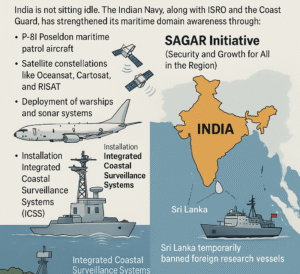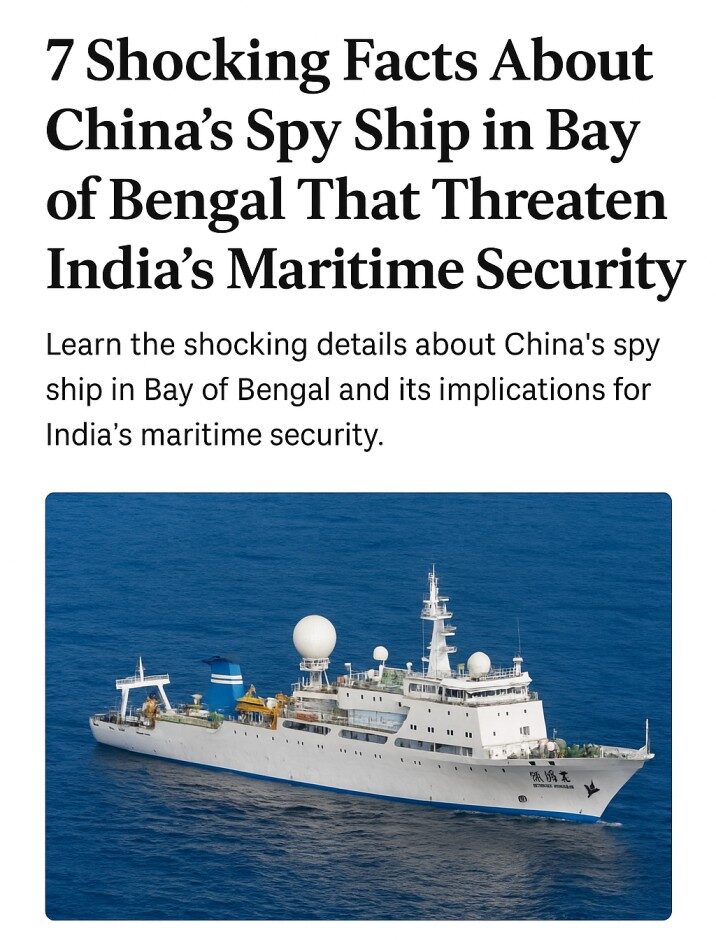China’s Secret Spy Ship in the Bay of Bengal: A Growing Threat to India’s Maritime Sovereignty. In a development that has raised red flags among strategic experts across South Asia, a Chinese spy vessel named Yang He Hao was recently detected operating covertly in the Bay of Bengal. According to a maritime intelligence report by the French agency Maritime Intelligences, the ship was present in Indian waters between late June and early July, often switching off its Automatic Identification System (AIS) to evade detection. This act signals deep concerns related to national sovereignty, surveillance, and maritime security in the Indo-Pacific region.
To put the risk into perspective, over 90% of global trade moves through maritime routes, with the Bay of Bengal serving as a vital link between India and ASEAN, the Middle East, and East Asia. India’s Exclusive Economic Zone (EEZ), which extends 200 nautical miles from its coastline, encompasses sensitive military assets, including the Arihant-class nuclear submarines, strategic missile test zones, and major naval bases. With nearly 75% of India’s strategic maritime infrastructure located on the eastern coast, unauthorized presence by Chinese surveillance ships can seriously undermine India’s maritime defence
1. What Happened: The Yang He Hao Mystery
The Chinese vessel Yang He Hao, officially designated as an oceanographic research ship, was tracked operating secretly without transmitting its AIS data — a clear violation of international maritime regulations. The vessel entered Indian EEZ waters without prior authorization, directly contravening Article 246 of the United Nations Convention on the Law of the Sea (UNCLOS), which mandates prior consent from coastal nations for any foreign scientific activity.
By deliberately disabling its AIS multiple times, Yang He Hao attempted to bypass Indian surveillance systems, possibly to collect sensitive data like undersea topography, current patterns, and acoustic signatures. Such intelligence is crucial for submarine warfare and missile tracking, a tactic suggesting that the so-called research mission was a camouflaged military espionage operation.
2. Why It Matters: Strategic Importance of the Bay of Bengal

The Bay of Bengal is not merely a shipping route — it’s a strategic zone of immense military significance. India conducts critical operations here, including missile testing, nuclear submarine deployments, and multilateral naval exercises like Malabar with the U.S. and Japan.
Unauthorized surveillance by adversarial ships in this region is dangerous. If China maps submarine routes or missile launch sites, it could potentially launch precision attacks in a wartime scenario. Even worse, collecting acoustic signatures of Indian submarines could make them identifiable and vulnerable in future conflicts.
3. Pattern of Chinese Behavior in the Indian Ocean
This isn’t the first time China has pushed boundaries in the Indian Ocean. Over recent years, Chinese “research” vessels such as the Xiang Yang Hong 01 and Yuan Wang-class ships have appeared frequently near:
Indian EEZ
Sri Lankan and Maldivian waters
Andaman and Nicobar Islands
These visits often align with Indian military events like missile trials, submarine activity, or international naval drills. This recurring pattern strongly indicates that China is systematically collecting defence intelligence under the guise of scientific exploration.
4. How China Exploits Dual-Use Technology
China’s so-called research ships are equipped with dual-use technologies that support both civilian and military operations. These vessels carry advanced equipment, including:
Sonar arrays for seabed mapping
Radar and signal intelligence systems
Cable tracking sensors
Hydrographic survey tools
These technologies enable them to monitor underwater surveillance grids, locate undersea internet cables, and intercept acoustic data from submarines. All of this enhances China’s ability to conduct undersea warfare, cyber intrusions, and disrupt critical infrastructure.
5. India’s Response: Strengthening Surveillance & Diplomacy

India is not sitting idle. The Indian Navy, along with ISRO and the Coast Guard, has strengthened its maritime domain awareness through:
P-8I Poseidon maritime patrol aircraft
Satellite constellations like Oceansat, Cartosat, and RISAT
Deployment of warships and sonar systems
Installation of Integrated Coastal Surveillance Systems (ICSS)
India has also launched the SAGAR initiative (Security and Growth for All in the Region) to build regional partnerships. On the diplomatic front, India has urged Sri Lanka and the Maldives to restrict Chinese ship access. While Sri Lanka temporarily banned foreign research vessels, there are concerns that Chinese diplomatic pressure might soon reverse the decision.
6. The Bigger Picture: China’s ‘String of Pearls’ Strategy
The activities of ships like Yang He Hao are part of China’s broader “String of Pearls” strategy — building a network of military and commercial infrastructure around India. Strategic ports include:
Gwadar (Pakistan)
Hambantota (Sri Lanka)
Kyaukpyu (Myanmar)
Chittagong (Bangladesh)
Djibouti (East Africa)
These ports allow China to refuel, dock, and gather intelligence, enabling maritime encirclement of India. Spy ships are the non-combat extension of this plan, preparing the stage for seabed warfare, cable tapping, and submarine counter-operations.
7. What Lies Ahead: India’s Call to Action
The detection of the Chinese ship in India’s EEZ is a wake-up call. It’s not merely an issue of sovereignty, but of strategic vulnerability. The stakes are high, and India must accelerate its maritime modernization.
India’s next steps should include:
Investing in AI-based surveillance satellites
Enhancing undersea cable protection infrastructure
Collaborating with QUAD and BIMSTEC allies
International campaigns to enforce UNCLOS laws
Expanding its dual-use naval research capacity
While India’s current response is multi-dimensional and firm, the challenge is ongoing. China’s ambitions in the Indian Ocean are not a passing phase — they’re a strategic reality.
Conclusion: Stay Alert, Stay Strong
The covert operation of China’s spy ship in the Bay of Bengal is a serious breach of international norms and a strategic threat to India. But it also serves as a crucial reminder — India must remain proactive, resilient, and innovative in defending its maritime frontiers.
This is not just about catching a ship — it’s about securing a region, a strategy, and a nation’s future.
To get more updates, visit: The Morning Draft.



